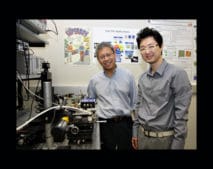Times Microwave Systems debuted the Times-Protect LP-GPX-05-T lightning protector for GPS receivers. The LP-GPX-05-T is a bidirectional filter-based design with good insertion loss and return loss characteristics from 1,000 to 2,000 MHz. The lightning protector is for GPS receivers that require as much as five volts DC power supplied on the center pin for L1, L2 and L3 bands. … [Read more...]
Front-End Solution Integrates RF Content Between Transceiver and Antenna
Skyworks Solutions, Inc. announced the launch of a front-end system that integrates all RF and analog content between the transceiver and antenna for simplified design within demanding next generation mobile platforms. SkyOne condenses multiband power amplifiers and high throw switches along with all associated filtering, duplexing and control functionality into a single, … [Read more...]
Multiple TVS Arrays for Lightning and ESD Protection
ProTek Devices introduced multiple transient voltage suppressor (TVS) arrays featuring a variety of configurations ideal for embedded transient voltage protection for applications such as Ethernet, USB, smartphones, and other portable electronics. ProTek's TVS Arrays product line provides protection from transients caused by Electrostatic Discharge (ESD), Electrical Fast … [Read more...]
Lightning Damage Costs Double for Electronics
The cost of insurance claims for lightning strikes nearly doubled between 2004 and 2011, and insured losses reached $1 billion last year alone according to a study by the Insurance Information Institute. The National Lightning Detection Network recorded nearly 23.4 million lightning flashes nationwide in 2011, but the rising cost isn’t entirely to do with the weather. In fact, … [Read more...]
High-Frequency RF and Microwave Multilayer Ceramic Capacitors
Vishay Intertechnology, Inc. introduced a new series of surface-mount multilayer ceramic chip capacitors offering high self-resonance, a high Q factor of 2000, and a low dissipation factor of 0.05 % for operation in high-frequency commercial applications. The MLCCs reduce signal loss and energy consumption in power amplifier modules, VoIP networks, cellular base stations, GPS … [Read more...]
FCC to Review Mobile-Phone Radiation Safety
The U.S. Federal Communications Commission plans to ask whether its standards protect people from mobile-phone radiation, a question it hasn’t posed in 15 years, as people use smartphones for longer, more frequent calls. A formal enquiry would review the FCC’s standards with the concerns of more frequent use, longer-use, new mobile-phone technology, and use by children in … [Read more...]
New Point-to-Point Interface that Reduces EMI & RFI in LCD Panels
Parade Technologies Ltd. has announced a new type of point-to-point high speed interface for use within LCD display panels. The new Scalable Intra Panel Interface, or SIPI™, achieves high data rate, low power use, and reduced interference with embedded system wireless services to meet the challenging demands for ultra-thin, high pixel density mobile displays. SIPI provides … [Read more...]
Team Finds New Cell Phone Possibilities in Untapped Terahertz Range
Researchers at University of Texas Dallas have designed a chip that could turn mobile phones into an imaging device capable of “seeing” through walls, wood, plastics, paper and other objects. The team used previous research completed on the terahertz band of the electromagnetic spectrum and new advances in imaging technology to design the chip. Learn more from UT … [Read more...]
Swiss Researchers: EM Radiation Can Indicate Keystrokes and Can Compromise Privacy
According to research carried out by doctoral students Sylvain Pasini and Martin Vuagnoux working in the Security and Cryptology Laboratory at the Ecole Polytechnique Fêdêrale in Lausanne, Switzerland computer keystrokes can be detected from afar by detecting slight changes in the electromagnetic radiation emitted by the keyboards. They concluded that keyboards should not be … [Read more...]
Fundamentals of EMC Design: Our Products Are Trying To Help Us
INTRODUCTION We often design electronic products only to find that when we test them for electromagnetic compatibility (EMC), their emissions and/or immunity are not as good as we need them to be. Usually, at this time, we feel as if we are fighting against the laws of physics to contain the conducted and radiated emissions, or to reduce susceptibility. But in fact the laws of … [Read more...]
- « Previous Page
- 1
- …
- 51
- 52
- 53
- 54
- 55
- …
- 68
- Next Page »














